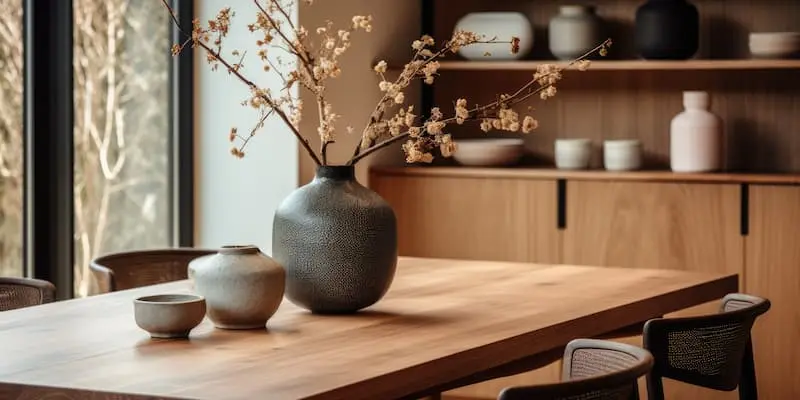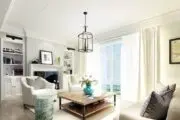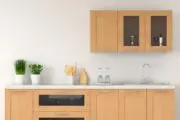Wood is one of the hottest 2024 interior design trends, with natural wood tones, painted panels, accents and details playing a major role in creating beautiful, warm spaces.
There is an art to decorating with wood. The goal is to create earthy depth that is light and airy, as opposed to dark and bulky, which can happen, given the visual and physical weight of wood as a design material.
Here are some tips on how you can bring the warmth of wood into your home to make it feel like a serene retreat.
Why is wood one of 2024’s hottest interior design trends?
Wood taps into the popular biophilic and Japandi styles, where warmth and rugged, nature-inspired colors and textures are prevalent. It helps to re-create the calming experience of being in nature.
“Natural wood finishes create warmth within our homes by showcasing woodgrain’s tone and beauty,” says WELL and LEED accredited interior designer Sarah Barnard.
“Wood flooring and paneling incorporate large swaths of warm natural wood tones to create cozy spaces that connect with the comfort and mindfulness of forest bathing,” says Barnard.
Blending natural wood tones
Keeping wood in its natural state is trending, but applying a strategy is important, so you experience the beauty of the wood, as opposed to the bulk.
The key is to blend wood tones.
“When mixing natural wood tones, consider playing with shape and texture to create subtle contrast within a space. Incorporating handmade wood furniture can be a great way to use wood slabs that have retained their original unmilled shape along their edges,” says Barnard.
“Natural forms such as burlwood and stumps can create beautiful and unique pieces of furniture with an organic shape that contrasts with smooth wood flooring or wall paneling,” she says.
From a color perspective, choose wood tones that are complementary to each other, such as dark walnut against oak or maple for visual balance.
The 60/30/10 color rule designers use with paint colors applies to wood tones as well. Dedicate 60 per cent of a specific tone as the main choice, with 30 per cent as a secondary, supplemental color and allocate 10 per cent to accents. You can use three different natural wood tones, or you can mix painted color in as a choice instead.
For example, matte black pairs well with several wood tones, and is a popular choice.
In addition to color, be mindful of wood grain, because that will influence the overall visual impact.
Shiplap is out, beadboard is in
Shiplap, commonly seen in the popular farmhouse, coastal and cottage core aesthetics is less popular, with wainscoting, in particular beadboard, taking its place as one of 2024’s hottest interior design trends.
Wainscoting typically occupies the lower half of a wall, and in addition to being decorative, serves to protect walls from wear and tear. It’s common in dining rooms, to keep from chairs scuffing the walls as they move in and out to accommodate diners.
The classic, clean lines of wainscoting are timeless and versatile. You can go with a simple trim, or more complex geometric patterns.
Amongst wainscoting choices, beadboard is one of the most popular. Homeowners are using it in a traditional wainscoting style on a half wall, or are using it for full accent walls, in much the same way shiplap has been used for years. For a rustic feel, use beadboard on walls, the floor and the ceiling.
Using natural wood tones in kitchen cabinetry
After years of all-white kitchens, color has made a bold re-introduction as a growing 2024 interior design trend. However, homeowners may understandably be nervous about committing to bright and splashy.
Incorporating natural wood tones, especially with kitchen cabinetry, strikes a good balance by infusing color and warmth in a subtle way.
Opt for lighter woods, such as oak, maple or birch for a hint of color. Darker woods, such as mahogany or cherry pack a dramatic punch, while adding a more rustic feel. If you choose darker tones, be aware of the presence of natural light, as well as the overall layout of the kitchen so that the space doesn’t feel cramped.
In addition to the color of the wood, pay attention to the grain, as this plays a significant role in the overall look of the cabinetry. Typically, for a crisper looking kitchen, you want grains to align, whereas for a more rustic feel, grains can be mismatched, adding rich, authentic patina.
Vertical grain is seen most often with traditional cabinetry and leverages the fact that cabinets are typically taller than wide, directing the eye upwards. Horizontal grains are being used more often for a modern feel with flat slab door styles, making the grain a more prominent focal point.
If you’d prefer to stick with painted cabinetry, you can introduce natural wood tones by including wooden countertops. Make sure that wood is well-sealed, given all the moisture in a kitchen. Marine-grade wood tends to be sturdier against water than butcher block, for example.
Fluted accents
Another wood feature getting attention in 2024 interior design trends is fluted accents, and is appearing everywhere: wall coverings, cabinetry and on accents and decor. It’s a simple but striking way to favor texture over color and add visual interest at the same time.
Effective both for its linear simplicity, and for the supporting role it plays in minimalist design, fluting’s understated, curved features add to the aesthetic unobtrusively.
- One popular way to use fluted detailing is with slatted wall panels. Not only do they add timeless style, wood-slat wall panels offer soundproofing, so are a great choice for a home office or bedroom.
- If you don’t want to commit to a full wall, incorporate fluting on a kitchen island, lower cabinetry or on built-in shelving.
- Fluting on furniture is popular, particularly on sideboards, cabinets, dressers and dining and end tables. Smaller accents, such as table lamps, with intricate fluted detailing on the base are pretty as well.









